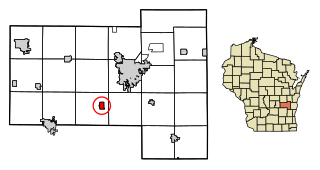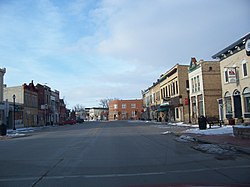
Mayville is a city in Traill County, North Dakota, United States. The population was 1,854 at the 2020 census. which makes Mayville the largest community in Traill County. Mayville was founded in 1881. The city's name remembers May Arnold, the first white child born in the immediate area.

Dover is a city in Tuscarawas County, Ohio, United States, along the Tuscarawas River. The population was 13,112 at the 2020 census. It is a principal city of the New Philadelphia–Dover micropolitan area, approximately 68 miles (109 km) south of Cleveland and borders the city of New Philadelphia.

Fountain City is a small city bordering the Mississippi River in Buffalo County, Wisconsin, United Stat]]. The population was 859 at the 2010 census. Fountain City is also known for where Northwest Airlines Flight 421 crashed.

Mayville is a town in Clark County in the U.S. state of Wisconsin. The population was 919 at the 2000 census.

Empire is a town in Fond du Lac County, Wisconsin, United States. The population was 2,620 at the 2000 census.

St. Cloud is a village in Fond du Lac County, Wisconsin, United States, along the Sheboygan River. The population was 489 at the 2020 census. St. Cloud is part of The Holyland region in northeastern Fond du Lac County.

Lancaster is a city in and the county seat of Grant County, Wisconsin, United States. The population was 3,907 at the 2020 census.

Markesan is a city in Green Lake County, Wisconsin, United States. The population was 1,377 at the 2020 census. The center of population of Wisconsin is located in Markesan.

Johnson Creek is a village in Jefferson County, Wisconsin, United States. The population was 3,318 at the 2020 census. The village is approximately halfway between Milwaukee and Madison, at the intersection of Wisconsin Highway 26 and Interstate 94.

Plum City is a village in Pierce County, Wisconsin, United States. The population was 599 at the 2010 census.

Shawano is a city and the county seat of Shawano County, Wisconsin, United States. The population was 9,243 at the 2020 census.

Barron is a city in and the county seat of Barron County, Wisconsin, United States. The population was 3,733 at the 2020 census. The city is surrounded by the Town of Barron.

Washburn is a city and the county seat of Bayfield County, Wisconsin, United States. The population was 2,051 at the 2020 census. The city is just east of and adjacent to the Town of Washburn. It is in northern Wisconsin, on the shore of Lake Superior's Chequamegon Bay.

Columbus is a city in Columbia and Dodge counties in the U.S. state of Wisconsin. The population was 5,540 at the 2020 census, all of which resided in Columbia County. Columbus is located about 28 miles (45 km) northeast of Madison on the Crawfish River. It is part of the Madison metropolitan area. Nearly all of the city is located within the town of Columbus in Columbia County, though a small portion lies within the town of Elba in Dodge County.

Oakfield is a village in Fond du Lac County, Wisconsin, United States. The population was 1,052 at the 2020 census. The village is located within the Town of Oakfield.

Waterloo is a city in Jefferson County, Wisconsin, United States. The population was 3,628 at the 2020 census. The name Waterloo was suggested by a French resident who was one of Napoleon's soldiers at the Battle of Waterloo. Waterloo is located in the Watertown–Fort Atkinson micropolitan area.

Necedah is a village in Juneau County, Wisconsin, United States. The population was 916 at the 2020 census. The village is located within the Town of Necedah.

Luck is a village in Polk County, Wisconsin, United States. The population was 1,119 at the 2010 census.

The Town of Clinton is a located in Rock County in the U.S. state of Wisconsin. The population was 2,190 at the 2000 census. The Village of Clinton is located in the town, though it is politically independent. The unincorporated community of Bergen is located in the town.

Oconomowoc is a town in Waukesha County, Wisconsin, United States. The population was 8,836 at the 2020 census. The City of Oconomowoc and the Villages of Chenequa and Lac La Belle are located partially in the town. The unincorporated communities of Mapleton, Monterey, and Okauchee Lake, are located in the town. The unincorporated community of Stone Bank is located partially in the town. And as of January 1st 2025 the town of Oconomowoc merged with Lac La Belle.


































